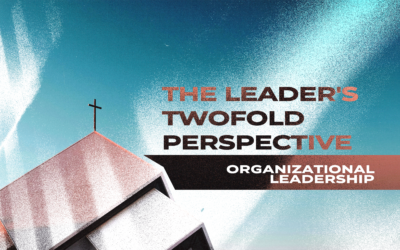One of the leader’s key responsibilities is to see his/her ministry/organization grow. For that organization to grow, people have to behave differently, do different things or do the same things in a different way.
One of the leader’s key discouragements is that these behavioral changes often do not happen.
Often the leader thinks the way to get people to behave in different ways is to change their behavior.
Big mistake.
A wise leader told me:
“You can either control people’s behavior or you can control the format…
and you cannot control their behavior.”
– Morris Owen
This one idea (guide the format and the behavior will follow) has been at the core of how I have led
- a declining network of churches to add 77 new churches over the last 14 years;
- an inner-city mission church to go from an average attendance of 23 people to an average of 67 people and 7 baptisms within nine months;
- a Christian non-profit to move from no identified spiritual engagements to 919 engagements in 2017 and 1,005 through July 2018;
- a Pastors’ & Wives’ Retreat to grow from a handful of people to having it full for over a decade;
- a mission to grow from one pastor/director to seven directors, one part-time coordinator, two part-time administrative support people and three interns who are now ready to launch site #2 in the next 12-24 months; and
- a church in the Midwest to increase its Sunday School attendance an average of 24% (to 524 people) over an eight-month period of time
So, it’s been kind of a big deal in my life.
Naturally, it is the way a Maryland blue crab grows. Early in my life, the food of choice for family cookouts were bushels of the luscious crustaceans. Some were bigger than others. The way a crab grows is not by growing the shell. A crab’s shell does not grow. For the crab to get bigger, it must lose its shell, spend sometime as a “soft-shelled crab” (which are really delicious) and the soft shell gets bigger and hardens. Then, the crab grows into the larger shell. At the family reunion crab table, a bigger crab did not always mean more meat. If the crab was captured right after the shell hardened, you got a crab with a big shell but not a lot of meat.
Organizations, like crabs, don’t outgrow old formats. They grow into new formats.
If you try to get people to act differently without changing the format, it won’t go very well. Or (at least) it won’t go well for very long. Just coaxing behavior can last as long as the prodding does. Once the coaxing ceases, the behavior reverts to its previous goings-on…or not goings-on, as the case may be.
Even if the behavioral change does stick, it would have gone easier if the format were changed first.
This principle not only applies mentally and behaviorally. It also shows up spatially.
Example!
You are (probably) sitting in a chair in a certain place in a room right now. Why?
Because someone else, (or it may have been you), put the chair in that place.
Someone decided the format of the room, including said chair, and you behaved into the format. That person led and to an extent, determined your behavior.
Watch a group enter a conference room and you will notice they typically will sit in the chairs provided in the places provided. They are acting into a previously determined format. Rarely would a person pick up a chair and move it to a different room and sit in there, when the rest of the group stays in the room where the chairs were placed. (Although I have seen it happen, it is the exception…and it also says something about the kinds of friends I have.)
To help an inner-city mission grow, you reformat what it is. The format is different, so people behave differently.
To turn around a declining network of churches, you reformat the expectations (the mental format) and the expectations are then the guardrails for behavior.
For a Pastors’/Wives’ Retreat, reformatting the staff and the structure and the space and the stuff resulted in many more people attending, with no blowback.
And, those are the things you format:
-
structure
-
staff
-
space
-
stuff
These are listed from most impacting to least impacting.
You change any one of those and you change the organization. Massive change results when you change all four. (Takeaway: If your church/organization needs massive change, look beyond a singular shift in format.)
This key leverage point (the format) can produce momentous change, while minimizing (or completely eliminating) pushback and aggravation for you (the leader).
Consider:
- You shape the room then the room shapes you.
- You build your house then your house builds you.
It’s an amazing thing to see a house built from the ground (or if it has a basement, from below the ground) up. Where once you could walk in the grass is now a place with a basement (sometimes), a foundation, walls, windows (you get the idea). Where you once walked you can no longer walk because there is now a wall. You built the house, now the house determines you can no longer walk across the grass there.
Another way of putting it:
Construct guides conduct.
What is true spatially (with the house) is true organizationally (with people). You build/construct/create a format (spatial or mental) and people behave into (or around) that configuration.
A rather tall friend of mine tells me of his trip down the basement stairs in the place he spent his early years. A lot of years. With each descent to the lower level, there was a part of the headspace that was lower than the rest, on or around step number seven. He regularly swung his head to the left, even when he was running down the steps to avoid getting his head whacked by the above-mentioned lower headspace. One-two-three-four-five-six-duck for seven-eight-nine (etc.). Every time. Any time he went into the basement. Somebody built it like that. He lived with it and adapted his behavior to the format of what was built.
Want to grow or change your organization?
Change the format to match the future.
In the comments below, share a format you have seen be effective to grow an organization.
Who We Are
LeaderINCREASE helps leaders get clear on where to go and understand how to get there, with less hassle. We understand that choosing to make a difference as a leader isn’t always the easiest.
We focus on providing leaders with resources they need to make a difference and become actionable leaders for their organization. We look forward to helping you achieve your goals as we have done for many others.




